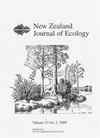Population responses of common lizards inside a predator-free dryland sanctuary
IF 1.4
3区 环境科学与生态学
Q3 ECOLOGY
引用次数: 0
Abstract
: Predator-free sanctuaries can assist the conservation of multiple endemic species, but quantitative evidence of these benefits is often lacking, especially for herpetofauna. We measured population responses of three common lizard species (schist geckos, Woodworthia ‘ Central Otago’; McCann’s skinks, Oligosoma maccanni ; and southern grass skinks, O. aff. polychroma Clade 5) 1 year before and 5 years after mammalian predators were removed inside a mammal-proof fence in a dry grass/shrubland habitat with abundant schist rock in Central Otago, New Zealand. Gecko counts in 25 artificial retreats (ARs) along replicated, 250-m long transects inside the fence increased from 5.2 to 17.7 per transect, compared with 3.3 to 5.4 per transect outside the fence where predators were present. This indicates a doubling of counts inside the fence when changes outside the fence are accounted for. The number of skinks seen along these transects increased from 1.3 to 2.3 per transect without predators, compared with 0.6 to 0.4 with predators. Lizard tracking tunnel indices (recorded only after predators were removed) were significantly higher without predators (62% geckos, 42% skinks) than where predators were present (12% geckos, 2% skinks). Tail loss in geckos was significantly higher where predators were present (24%) than where they were absent (1%). These data suggest that common lizard species are being suppressed to a significant degree by mammalian predators and demonstrate the potential for their recovery where predators are removed.无捕食者的旱地保护区中常见蜥蜴的种群反应
本文章由计算机程序翻译,如有差异,请以英文原文为准。
求助全文
约1分钟内获得全文
求助全文
来源期刊

New Zealand Journal of Ecology
环境科学-生态学
CiteScore
3.00
自引率
12.50%
发文量
35
审稿时长
>36 weeks
期刊介绍:
The New Zealand Journal of Ecology is a biannual peer-reviewed journal publishing ecological research relevant to New Zealand/Aotearoa and the South Pacific. It has been published since 1952 (as a 1952 issue of New Zealand Science Review and as the Proceedings of the New Zealand Ecological Society until 1977). The Journal is published by the New Zealand Ecological Society (Inc.), and is covered by Current Contents/Agriculture, Biology and Environmental Science, GEOBASE, and Geo Abstracts.
 求助内容:
求助内容: 应助结果提醒方式:
应助结果提醒方式:


